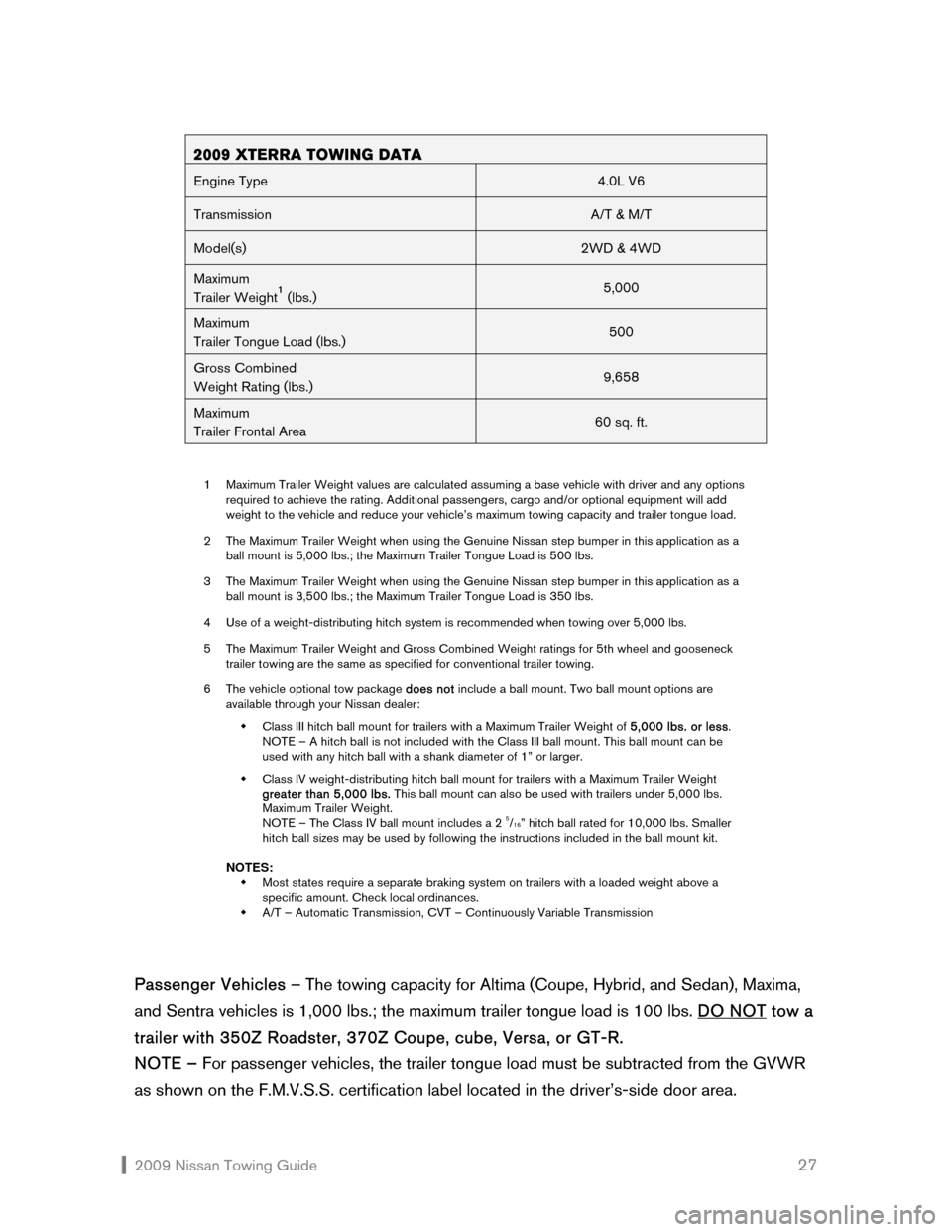2009 NISSAN VERSA HATCHBACK automatic transmission
[x] Cancel search: automatic transmissionPage 20 of 32

2009 Nissan Towing Guide 19 vehicle. A special extended 5th wheel pin box or sliding hitch may be required to provide
additional trailer-to-truck clearance for tight maneuvering.
BACK UP WITH CAUTION
Backing up with a trailer is a difficult maneuver; however, there is a “trick” that can simplify the
procedure considerably. Simply steer with one hand at the bottom of the steering wheel. To
turn the trailer to the left, first move the steering wheel to the left. To turn the trailer to the
right, move the wheel to the right. All movements of the wheel should be done in small
increments. Of course, backing up should be done only at very slow speeds. For large trailers
that obstruct your rearward vision, have someone outside the vehicle act as a “spotter” to
guide you along.
PARK SMART
A tow vehicle and trailer can be an unwieldy combination in a small area, so always try to park
where you will have a relatively easy time maneuvering. Once parked, always block the wheels
on both the tow vehicle and the trailer.
Parking on a slope is not recommended. If, however, you must park on a slope and your
vehicle is equipped with an automatic transmission, there are some precautions you should
take:
�Š Have someone block the wheels once the tow vehicle and trailer are in position and being
held by the vehicle’s brake.
�Š Next, apply the parking brake and only then move the gear lever into PARK. If you move the
lever into PARK before blocking the wheels and applying the parking brake, transmission
damage may occur.
HIGH-ALTITUDE PERFORMANCE
An engine will lose about 4% of its performance for every 1,000 feet above sea level that you
travel. If you will be towing in high altitudes, it is a good idea to allow more time than usual due
to the engine’s reduced performance.
TOW MODE (IF EQUIPPED)
Tow Mode is recommended when towing a heavy trailer or hauling a heavy load, particularly
when stop-and-go traffic, rolling terrain, or a busy parking lot is involved.
Driving the vehicle in Tow Mode with minimal trailer load will not cause any damage;
however, fuel economy may be reduced and transmission/engine driving characteristics may
feel different. See your vehicle owner’s manual for additional information about Tow Mode.
Page 21 of 32

2009 Nissan Towing Guide 20 HILLS – UPGRADES
As the incline increases, your vehicle — if equipped with an automatic transmission — is
designed to automatically select the correct gear for the best towing comfort and
performance. To maintain speed or avoid up and down shifts, manually shift to a lower gear as
needed.
The added weight of a trailer places an increased load on the engine and cooling system,
so monitor your coolant temperature gauge and automatic transmission fluid temperature
gauge (if equipped) very carefully. At the first sign of overheating, pull to the side of the road.
See IF YOUR ENGINE OVERHEATS later in this section for more information.
HILLS – DOWNGRADES
While going downhill, the weight of the trailer pushing on the tow vehicle may decrease
overall stability. Therefore, to maintain adequate control, reduce your speed and shift to a
lower gear. If your vehicle is equipped with Tow Mode, see your vehicle owner’s manual for
information about the use of this function.
Avoid long or repeated use of the brakes when descending a hill, as this reduces their
effectiveness and could cause overheating. Shifting to a lower gear instead provides “engine
braking” and reduces the need to brake as frequently.
AUTOMATIC CRUISE CONTROL
Do not use cruise control while towing a trailer.
IF YOUR ENGINE OVERHEATS
A moderate increase in engine operating temperature is normal when towing a trailer. If,
however, the coolant temperature gauge reading is abnormally high, or if you are experiencing
a significant loss of power, or if you hear unusual engine noises,* the engine may be
overheating and you should immediately take the following steps:
1. Pull your vehicle safely over to the side of the road, out of traffic. Apply the parking brake
and move the gearshift lever to NEUTRAL (manual) or PARK (automatic). DO NOT STOP
THE ENGINE.
2. Turn off the air conditioning and, after opening all the windows, turn the heater on to
maximum hot and the fan to its highest speed. The heater core in your vehicle is just like a
miniature engine radiator and will provide an extra cooling surface to help reduce engine
temperature.
3. If the temperature does not drop or continues to increase, stop the engine immediately.
*See your vehicle owner’s manual for additional indications that your vehicle may be overheating.
Page 28 of 32

2009 Nissan Towing Guide 27
Passenger Vehicles – The towing capacity for Altima (Coupe, Hybrid, and Sedan), Maxima,
and Sentra vehicles is 1,000 lbs.; the maximum trailer tongue load is 100 lbs. DO NOT
tow a
trailer with 350Z Roadster, 370Z Coupe, cube, Versa, or GT-R.
NOTE – For passenger vehicles, the trailer tongue load must be subtracted from the GVWR
as shown on the F.M.V.S.S. certification label located in the driver’s-side door area.
2009 XTERRA TOWING DATA
Engine Type 4.0L V6
Transmission A/T & M/T
Model(s) 2WD & 4WD
Maximum
Trailer Weight1 (lbs.) 5,000
Maximum
Trailer Tongue Load (lbs.) 500
Gross Combined
Weight Rating (lbs.) 9,658
Maximum
Trailer Frontal Area 60 sq. ft.
1 Maximum Trailer Weight values are calculated assuming a base vehicle with driver and any options
required to achieve the rating. Additional passengers, cargo and/or optional equipment will add
weight to the vehicle and reduce your vehicle’s maximum towing capacity and trailer tongue load.
2 The Maximum Trailer Weight when using the Genuine Nissan step bumper in this application as a
ball mount is 5,000 lbs.; the Maximum Trailer Tongue Load is 500 lbs.
3 The Maximum Trailer Weight when using the Genuine Nissan step bumper in this application as a
ball mount is 3,500 lbs.; the Maximum Trailer Tongue Load is 350 lbs. 4 Use of a weight-distributing hitch system is recommended when towing over 5,000 lbs. 5 The Maximum Trailer Weight and Gross Combined Weight ratings for 5th wheel and gooseneck
trailer towing are the same as specified for conventional trailer towing.
6 The vehicle optional tow package does not include a ball mount. Two ball mount options are
available through your Nissan dealer:
�Š Class III hitch ball mount for trailers with a Maximum Trailer Weight of 5,000 lbs. or less.
NOTE – A hitch ball is not included with the Class III ball mount. This ball mount can be
used with any hitch ball with a shank diameter of 1” or larger.
�Š Class IV weight-distributing hitch ball mount for trailers with a Maximum Trailer Weight
greater than 5,000 lbs. This ball mount can also be used with trailers under 5,000 lbs.
Maximum Trailer Weight.
NOTE – The Class IV ball mount includes a 2
5/16” hitch ball rated for 10,000 lbs. Smaller
hitch ball sizes may be used by following the instructions included in the ball mount kit.
NOTES:
�Š Most states require a separate braking system on trailers with a loaded weight above a
specific amount. Check local ordinances.
�Š A/T – Automatic Transmission, CVT – Continuously Variable Transmission